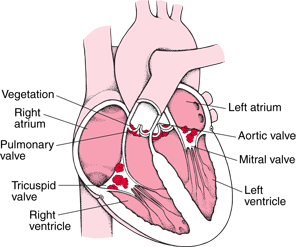
What is infective endocarditis?
An infection of the inner lining of the heart chambers and valves is called as infective endocarditis. Though rare, it can cause serious heart damage.
How does the infection occur?
Bacteria or fungi enter the bloodstream and attach inside the heart, where they multiply and cause infection.
Smooth lining of a normal heart resist bacterial infection. However, in setting of damaged heart valves or altered turbulent flow make heart lining susceptible to infection by micro-organism. Those with abnormal valves, ( leaky or narrow) , artificial valves, complex heart defects, abnormal communication or shunt , patent arterial duct, ventricular septal defect etc are at high risk of acquiring infection.
How do the bacteria or fungi get inside the body?
Common routed for entry are
- Dental procedures (including professional teeth cleaning)
- Tonsillectomy or adenoidectomy
- Examination of the respiratory passageways with an instrument known as a rigid bronchoscope
- Certain types of surgery on the respiratory passageways, the gastrointestinal tract, or the urinary tract
- Gallbladder or prostate surgery
Routing activities like brushing teeth can also lead to bacterial entry.
Who is at risk for bacterial endocarditis?
Following sets of patients are at increased risk of infective endocarditis
- Congenital heart disease
- Valvular heart disease
- After heart valve replacement
These condition leads to turbulence across the lesions and increases chances of colonization of organism.
Antibiotic prophylaxis recommended for specified heart conditions who are at high risk of infective endocarditis. It is used before certain dental and invasive procedures. Antibiotic prophylaxis is now recommended for:
- Prosthetic (artificial) heart valves
- A previous history of endocarditis
- Some congenital heart disease
- Heart transplant with heart valve disease
Consult your child’s healthcare provider with any further questions you may have about risk factors.
How is bacterial endocarditis diagnosed?
In addition to a complete medical history and physical exam of your child, other tests may include:
- 2D Echocardiogram (echo) It gives images of heart valves and highly helpful for diagnose
- Trans esophageal echocardiography: As the infective vegetation can be small, heart is examined with a special probe inserted in food pipe. It is highly sensitive test.
- Blood culture Organism are grown in blood are grown in laboratory. It help to formulate antibiotic therapy.
How is bacterial endocarditis prevented?
Bacterial endocarditis can’t be entirely prevented, but helping your child maintain excellent oral hygiene is an important step in preventing bacterial endocarditis. Regular visits to the dentist for professional cleaning and check-ups are essential. In addition, if applicable, education and awareness of your child’s heart condition, and the need for antibiotics prior to dental and medical procedures, can be helpful for your child’s healthcare providers.
Treatment for bacterial endocarditis
It is a serious infection and cardiologist will formulate therapy with appropriate IV antibiotics. It is administered over several weeks.
Heart valve can be damaged by infection and surgery may ultimately be required to repair or replace a damaged heart valve. Consult your child’s healthcare provider for more information.
